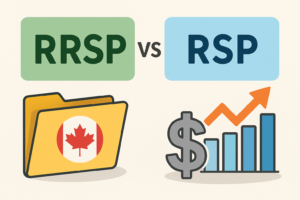Understanding the difference between RSP vs RRSP in Canada can help avoid costly mistakes and ensure you’re making the most of your investment.
Many Canadians use these terms interchangeably, but there’s an important distinction between the two.
While both are tools for saving, especially for retirement, they operate differently when it comes to taxation, contribution rules, and how they’re managed.
If you are looking to invest as an expat or high-net-worth individual, which is what I specialize in, you can email me (hello@adamfayed.com) or WhatsApp (+44-7393-450-837).
This includes if you are looking for a second opinion or alternative investments.
Some facts might change from the time of writing. Nothing written here is financial, legal, tax, or any kind of individual advice or a solicitation to invest.
This post will break down the difference between RSP and RRSP, including tax implications, registration details, and other considerations.

What is RRSP in Canada?

A Registered Retirement Savings Plan (RRSP) is a government-registered account in Canada designed to help individuals save for retirement.
Contributions made to an RRSP are tax-deductible, meaning they can reduce your taxable income for the year, offering immediate tax savings.
Additionally, investments inside an RRSP grow tax-deferred until withdrawal, allowing savings to compound more efficiently over time.
Some key features of an RRSP include:
- Tax-deferred growth: Investment earnings such as interest, dividends, and capital gains are not taxed while they remain in the account.
- Annual contribution limits: The contribution room is based on 18% of your earned income from the previous year, up to a maximum limit set annually by the Canada Revenue Agency (CRA). For 2024, the RRSP contribution limit is CAD 31,560.
- CRA registration: An RRSP must be formally registered with the CRA to enjoy its tax advantages. Contributions are tracked through your CRA account to ensure compliance with limits.
RRSPs can hold a wide range of investments, including stocks, bonds, mutual funds, GICs, and ETFs, offering flexibility depending on your risk tolerance and retirement goals.
How to Register an RRSP with the CRA
When it comes to registering a Registered Retirement Savings Plan, individual account holders don’t register their RRSPs directly with the Canada Revenue Agency.
Instead, this process is handled by financial institutions (such as banks, credit unions, or investment firms) when you open an RRSP account with them.
What is the Meaning of RSP Funds?
An RSP, or Retirement Savings Plan, is a broad, non-specific term used by financial institutions to refer to retirement-related investment accounts.
In many cases, banks label RRSPs (Registered Retirement Savings Plans) simply as “RSPs” for simplicity in online banking or account statements.
However, this can cause confusion, especially for Canadians trying to track their contribution room or understand their tax obligations.
Note that not all RSPs are officially registered with the Canada Revenue Agency.
This distinction matters: an RRSP is a specific type of RSP that comes with defined tax benefits, government recognition, and contribution tracking.
Meanwhile, a generic RSP could refer to any savings account geared toward retirement without the legal or tax-deferred features of a registered account.
When reviewing your financial portfolio, always confirm whether your “RSP” is truly an RRSP, especially if you’re relying on it for tax deductions or long-term retirement planning.

Difference Between RSP and RRSP
While RSP and RRSP are often used interchangeably, there are key distinctions between the two that impact how your retirement savings are managed and taxed.
| Feature | RSP (Retirement Savings Plan) | RRSP (Registered Retirement Savings Plan) |
| Terminology | General term used by banks and institutions | Official term under the Canadian Income Tax Act |
| Registration | May or may not be registered with CRA | Always registered with CRA |
| Tax Benefits | No guaranteed tax benefits | Contributions are tax-deductible; investments grow tax-deferred |
| Contribution Room | Not monitored by CRA | Subject to CRA-assigned annual limit |
| Withdrawal Rules | Varies by account type | Specific rules; early withdrawal may trigger taxes |
RSP vs RRSP Tax Return: What You Should Know
When it comes to taxes, RRSP contributions can significantly reduce your taxable income.
This means that the more you contribute to your RRSP, the lower your income tax bill for the year.
This is one of the major tax benefits of using RRSPs as part of your retirement savings plan.
By contributing to your RRSP, you are deferring taxes until you withdraw funds, usually during retirement, when your income might be lower.
Are RSP Contributions Tax-Deductible?
In Canada, only contributions to Registered Retirement Savings Plans are eligible for tax deductions.
This means that if your “RSP” is not officially registered with the Canada Revenue Agency, your contributions won’t lower your taxable income.
Many financial institutions use the term “RSP” as a catch-all label for retirement savings products, which can lead to confusion.
Just because your account is called an RSP doesn’t guarantee it’s CRA-registered.
To confirm whether your RSP is officially recognized as an RRSP:
- Log in to your CRA My Account to check your RRSP deduction limit and contribution history.
- Ask your bank or advisor if your RSP is registered with the CRA.
- Review your account paperwork for RRSP-specific language and CRA reporting details.
Mislabeling your RSP as an RRSP can have serious tax implications.
Financial institutions may mistakenly call an RRSP an “RSP” on statements or marketing materials, causing confusion about its registration status.
If the account is not properly registered with the CRA as an RRSP, it won’t qualify for the tax advantages provided by the Income Tax Act.
This means you could lose out on tax deductions and tax deferral benefits which may lead to unexpected tax liabilities and penalties when filing your returns.
RSP vs RRSP Withdrawals Tax
When it comes to withdrawals, both RRSP and RSP plans (if registered) are subject to taxation.
However, RRSPs are taxed as ordinary income when withdrawn, meaning the amount you withdraw is added to your income for that year and taxed at your marginal tax rate.
The same applies to RSPs if they are recognized by the CRA, but the taxation is dependent on the specific rules set by the institution offering them.
It’s important to consult with your financial advisor or institution to understand exactly how and when you’ll be taxed on withdrawals.
In short, contributing to an RRSP helps reduce your taxable income in the short term, but withdrawals will be taxed when you take the money out, generally in retirement.
RSP vs RRSP Canada: Conclusion
Understanding the tax benefits and risks associated with RSPs and RRSPs is crucial for optimizing your retirement savings strategy in Canada.
Make sure that any contributions to your RRSP are accurately recorded, and be mindful of the withholding taxes when you make withdrawals.
Proper management of these factors can maximize your savings and ensure you’re getting the most from your RRSP in terms of tax benefits.
Pained by financial indecision?

Adam is an internationally recognised author on financial matters with over 830million answer views on Quora, a widely sold book on Amazon, and a contributor on Forbes.



